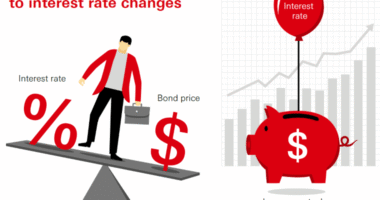The cash comeback nobody saw coming
After years of debt-heavy balance sheets and margin pressure, the world’s largest corporations are entering 2026 with something few expected — record cash reserves.
From New York to Tokyo, global firms have quietly rebuilt liquidity buffers, with total corporate cash holdings surpassing $8.3 trillion, according to the latest IMF data. This is more than double the pre-pandemic level and the highest in history.
Unlike the speculative liquidity of the 2020 stimulus era, this time the cash is earned, not borrowed — built through efficiency, strategic deleveraging, and a rebound in profitability.
The question now dominating boardrooms and investment desks alike: What will corporations do with all this cash?
How corporate liquidity hit record highs
The path to today’s cash abundance began during the inflation storm of 2022–2023. Rising rates and volatile demand forced companies to prioritize survival, slashing costs and paying down debt.
When revenues rebounded in 2024–2025 — powered by AI-driven productivity, reshoring, and disciplined pricing — margins improved dramatically. Rather than spend immediately, corporations banked the gains.
Key drivers of the liquidity surge:
-
Deleveraging during the high-rate era — Firms refinanced conservatively and avoided overleveraging.
-
Inventory discipline — AI-powered logistics reduced working capital needs.
-
Capex efficiency — Targeted automation and digital upgrades replaced broad expansion.
-
Shareholder restraint — Companies delayed major buybacks and M&A until visibility improved.
The result: balance sheets are healthier, leverage ratios are lower, and corporate cash-to-debt ratios are at their strongest since 2009.
Who’s holding the most cash?
United States
American tech and healthcare giants lead the global liquidity buildup. The top 20 U.S. corporations now hold over $1.8 trillion in cash, with Apple, Alphabet, and Microsoft alone accounting for more than $500 billion.
Industrial and energy firms have also joined the ranks, flush with profits from efficiency gains and stable energy prices.
Europe
European corporations, long criticized for weak profitability, are finally catching up. Stronger exports, stable inflation, and cautious dividend policies have allowed many to build large liquidity cushions. German and French industrials are particularly cash-rich heading into 2026.
Asia-Pacific
Japanese and South Korean companies have accumulated record reserves, while Chinese firms — after two years of regulatory uncertainty — are rebuilding war chests for global expansion. India’s corporate sector, bolstered by robust domestic demand, has also seen a surge in retained earnings.
Together, Asia’s top 500 firms now hold over $2.4 trillion in cash, up 35% from 2023.
Why this matters: the power of cash in a cooling economy
Cash isn’t just a balance-sheet number — it’s strategic ammunition. In a world where growth is moderating and credit spreads are narrowing, liquidity provides optionality.
Corporations with strong cash positions can:
-
Accelerate M&A when valuations are low.
-
Invest in innovation without borrowing.
-
Sustain dividends even during market volatility.
-
Weather geopolitical or supply shocks with minimal disruption.
Cash is becoming the ultimate competitive advantage in 2026 — not leverage, not risk, but financial resilience.
The investment wave is coming
While companies have been cautious so far, signs suggest they’re preparing to deploy capital aggressively in 2026.
1. Strategic M&A revival
Deal pipelines are filling again. With financing costs easing and valuations normalizing, M&A activity is projected to rise by 25–30% next year.
Expect focus on:
-
AI and data infrastructure acquisitions
-
Clean energy vertical integration
-
Supply chain reshoring partnerships
2. Shareholder returns rebound
Dividends and buybacks are set for a comeback. Analysts expect S&P 500 payouts to rise 10–12% in 2026 after a quiet two years. European firms are also expected to lift distributions as confidence returns.
3. Innovation reinvestment
The biggest story may be a fresh capex renaissance, led by technology, industrial automation, and renewable energy. Firms are investing in digital capacity, R&D, and infrastructure upgrades to drive long-term growth — without relying on external financing.
Market implications: cash-rich companies are outperforming
Investors are already rewarding firms with strong liquidity and disciplined capital allocation.
A recent Goldman Sachs study found that companies in the top decile of cash-to-debt ratios have outperformed global equity indices by 9% year-to-date.
The reason? Liquidity lowers risk. In uncertain environments, investors favor firms that can self-finance growth rather than depend on capital markets.
Cash also enhances strategic agility — allowing companies to pivot faster when new opportunities or crises emerge.
Sector breakdown: where the cash is concentrated
| Sector | 2025 Global Cash Holdings (USD Trillions) | Outlook for 2026 |
|---|---|---|
| Technology | 2.1 | Strong; expected reinvestment in AI and cloud |
| Healthcare | 1.3 | Moderate; R&D expansion and acquisitions |
| Industrials | 1.2 | Rising; infrastructure and automation |
| Financials | 1.0 | Stable; regulatory capital and buybacks |
| Energy | 0.9 | High; renewables and transition projects |
| Consumer & Retail | 0.8 | Moderate; digital expansion and brand acquisitions |
The tech and industrial sectors dominate, but even traditional sectors like energy and retail are flush with liquidity — positioning for the next growth cycle.
Cash deployment risks
While record liquidity is generally positive, there are potential pitfalls if companies mismanage it.
1. Idle capital
Too much cash sitting idle can depress returns on equity and signal poor strategic vision. Shareholders may pressure boards to act decisively.
2. Misallocation
Rushed buybacks or overpriced acquisitions could destroy value if executed without discipline.
3. Inflation risk redux
If global inflation unexpectedly reaccelerates, cash could lose real value — incentivizing premature spending.
4. Policy shifts
Governments may tighten corporate tax loopholes or impose levies on excess reserves, especially in Europe and Asia, where policymakers want firms to “put cash to work.”
The smartest firms will balance liquidity with long-term productivity investments rather than one-off financial engineering.
How investors can capitalize on the cash cycle
1. Target cash-rich companies
Look for firms with strong net cash positions, high free cash flow, and low debt-to-equity ratios. These tend to outperform in low-volatility markets.
2. Focus on capital deployment catalysts
Identify companies poised to announce M&A, dividend increases, or major reinvestments. Early positioning often yields outsized returns.
3. Play the buyback theme
Firms reinstating large repurchase programs often see multiple expansion as earnings per share rise.
4. Watch for private market spillovers
Private equity and venture capital are eyeing corporate partnerships as cash-rich firms look to deploy liquidity through strategic alliances.
The macro link: corporate cash and monetary policy
Interestingly, the corporate cash boom also reinforces monetary stability. As firms self-finance more of their growth, dependence on bank credit decreases, reducing systemic risk.
Central banks, in turn, can maintain moderate rates without choking liquidity. This feedback loop supports a “soft landing equilibrium” — steady growth, contained inflation, and stable credit markets.
In essence, corporate liquidity is acting as a private-sector buffer for global monetary policy — a quiet but powerful stabilizing force.
Case study: Apple and the “fortress balance sheet” philosophy
Apple Inc. remains the poster child of liquidity management. With over $165 billion in cash and marketable securities, the company operates with precision:
-
Reinvesting in high-margin innovation (AI, silicon design)
-
Returning cash via steady buybacks
-
Maintaining flexibility for acquisitions
This playbook — cash-rich, debt-light, and strategically agile — has become the global benchmark for corporate finance discipline.
The broader meaning: from survival to strategy
The corporate cash revival marks the end of the crisis mindset that dominated business strategy for half a decade. It reflects a transition from defensive liquidity to offensive capital deployment.
Companies aren’t hoarding cash out of fear anymore—they’re building firepower for opportunity.
This shift will define 2026’s market tone: more investment, more innovation, and more shareholder engagement. The global economy may be growing moderately, but beneath the surface, corporate liquidity is igniting a new expansion cycle.









